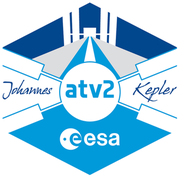Johannes Kepler ATV

Johannes Kepler in orbit, prior to its rendezvous with the ISS
|
|
| Mission type | ISS resupply |
|---|---|
| Operator | European Space Agency |
| COSPAR ID | 2011-007A |
| SATCAT no. | 37368 |
| Spacecraft properties | |
| Spacecraft type | ATV |
| Manufacturer |
EADS Astrium Thales Alenia Space |
| Launch mass | 20,050 kilograms (44,200 lb) |
| Start of mission | |
| Launch date | 16 February 2011, 21:51 UTC |
| Rocket | Ariane 5ES |
| Launch site | Kourou ELA-3 |
| Contractor | Arianespace |
| End of mission | |
| Disposal | Deorbited |
| Decay date | 21 June 2011, 20:44 UTC |
| Orbital parameters | |
| Reference system | Geocentric |
| Regime | Low Earth |
| Inclination | 51.6 degrees |
| Docking with ISS | |
| Docking port | Zvezda Aft |
| Docking date | 24 February 2011, 15:59:19 UTC |
| Undocking date | 20 June 2011, 15:46 UTC |
 |
|
The Johannes Kepler ATV, or Automated Transfer Vehicle 002 (ATV-002), was an unmanned cargo spacecraft built to resupply the International Space Station (ISS). It was launched on 16 February 2011 by the European Space Agency (ESA).Johannes Kepler carried propellant, air and dry cargo weighing over 7,000 kilograms (15,000 lb), and had a total mass of over 20,000 kilograms (44,000 lb), making it, at the time, the heaviest payload launched by the ESA. The spacecraft was named after the 17th-century German astronomer Johannes Kepler.
Johannes Kepler was the second ATV cargo resupply vehicle to be launched, following the Jules Verne mission of 2008. Johannes Kepler carried around five tons more cargo than Russia's Progress-M resupply spacecraft, and about 1.5 tons more than the Japanese HTV. The ATV used 4,500 kilograms (9,900 lb) of fuel to boost the ISS's altitude from 350 to 400 km.
Many of the supplies aboard the ATV were used for the Space Shuttle mission STS-133 and the ISS Expedition 26. A Reentry Breakup Recorder was placed aboard the ATV before it undocked from the ISS on 20 June 2011.Johannes Kepler performed a destructive re-entry as intended on 21 June 2011, with its remains impacting the Pacific Ocean.
Johannes Kepler consisted of two sections: the Propulsion Module, with four main engines and 28 smaller maneuvering thrusters, and the Integrated Cargo Carrier, which attached directly to the ISS and could hold up to eight standard payload racks. The four solar wings of the spacecraft provided up to 4,800 watts of electrical power to its rechargeable batteries.
...
Wikipedia
